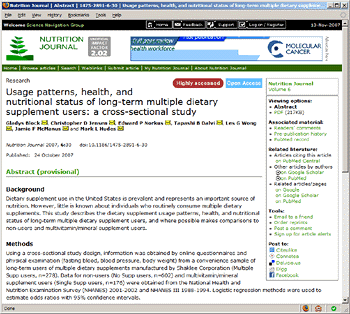 A recent article published in BioMed Central’s open access Nutrition Journal concerning the usage patterns of dietary supplements and the health and nutritional status of their users has been downloaded from the journal’s website over 16,000 times since publication on October 24th.
A recent article published in BioMed Central’s open access Nutrition Journal concerning the usage patterns of dietary supplements and the health and nutritional status of their users has been downloaded from the journal’s website over 16,000 times since publication on October 24th.
These remarkable access statistics demonstrate the extent to which open access journals can enhance the dissemination of
research, and emphasize the readiness of members of the public to dig behind the media coverage to read original research articles when they are accessible.
Ben Goldacre, on his excellent Bad Science blog, recently discussed the contrasting case of a research article, published in the Journal of the American Medical Association (JAMA) and widely covered in the popular media, which reported on the relative effectiveness of acupuncture, "sham acupuncture" and standard medical treatment in the treatment of lower back pain.
Lower back pain, like nutritional supplement usage, is an issue of relevance to a large fraction of the general population. Despite this, however, Goldacre’s attempts to persuade JAMA to make the article freely available so that the public could read it for themselves were unsuccessful – particularly problematic considering that, as discussed by Goldacre, much of the media coverage failed to convey the key result of the research, which was that there was no statistically significant difference in the effectiveness of ‘real’ and ‘sham’ acupuncture.
Public access to relevant medical research is not the only benefit of open access publishing, but it is a significant one. For other examples of recent articles that have attracted a wide readership, see BioMed Central ‘Most viewed’ page.
that’s extremely interesting, where did those 16000 readers come from, did the media pick up on that study? and did any journalist direct readers to the original paper?
Ben,
Digging into the scenario behind the high levels of access to this article, it is a rather interesting story.
It isn’t an article that was press released by BioMed Central, but it did pick up coverage on nutrition-related websites such as this one.
Those sources accounted for only a small fraction of the referrals which sent users to the article, however.
The vast majority came from people linking from(a) emails that they had been sent (which shows up in the form of webmail referral URLs, and/or blank referral URLs in the case of referrals coming from email clients like Outlook)(b) online forums for nutritional supplement users(c) online forums for sellers of nutritional supplements, especially the particular brand of supplement (Shaklee) used in the research.
The case actually provides a very nice example of a scenario where open access to the full text is extremely useful, for professional and lay person alike.
There is clearly a danger, with research like this, that journalists, not to mention those with a financial interest in the supplement concerned, might exaggerate the benefits suggested by a study, or might neglect to mention the caveats which apply to its interpretation of the data. But because the fulltext is open access, anyone is free to read it in and to review and to comment on or criticize the details of the methodology or interpretation.
The funding of the study (which came from Shaklee), and the competing interests of the researchers, are clearly set out in the article. Not only that, but because Nutrition Journal operates an open peer review policy, the external peer reviewers’ identities. their comments and criticisms, and the authors responses and revisions, are all open to scrutiny.